The Samsung Galaxy S10+ Snapdragon & Exynos Review: Almost Perfect, Yet So Flawed
by Andrei Frumusanu on March 29, 2019 9:00 AM ESTInference Performance: APIs, Where Art Thou?
Having covered the new CPU complexes of both new Exynos and Snapdragon SoCs, up next is the new generation neural processing engines in each chip.
The Snapdragon 855 brings big performance improvements to the table thanks to a doubling of the HVX units inside the Hexagon 690 DSP. The HVX units in the last two generations of Snapdragon chips were the IP blocks who took the brunt of new integer neural network inferencing work, an area the IP is specifically adept at.
The new tensor accelerator inside of the Hexagon 690 was shown off by Qualcomm at the preview event back in January. Unfortunately one of the issues with the new block is that currently it’s only accessible through Qualcomm’s own SDK tools, and currently doesn’t offer acceleration for NNAPI workloads until later in the year with Android Q.
Looking at a compatibility matrix between what kind of different workloads are able to be accelerated by various hardware block in NNAPI reveals are quite sad state of things:
| NNAPI SoC Block Usage Estimates | |||
| SoC \ Model Type | INT8 | FP16 | FP32 |
| Exynos 9820 | GPU | GPU | GPU |
| Exynos 9810 | GPU? | GPU | CPU |
| Snapdragon 855 | DSP | GPU | GPU |
| Snapdragon 845 | DSP | GPU | GPU |
| Kirin 980 | GPU? | NPU | CPU |
What stands out in particular is Samsung’s new Exynos 9820 chipset. Even though the SoC promises to come with an NPU that on paper is extremely powerful, the software side of things make it as if the block wouldn’t exist. Currently Samsung doesn’t publicly offer even a proprietary SDK for the new NPU, much less NNAPI drivers. I’ve been told that Samsung looks to address this later in the year, but how exactly the Galaxy S10 will profit from new functionality in the future is quite unclear.
For Qualcomm, as the HVX units are integer only, this means only quantised INT8 inference models are able to be accelerated by the block, with FP16 and FP32 acceleration falling back what should be GPU acceleration. It’s to be noted my matrix here could be wrong as we’re dealing with abstraction layers and depending on the model features required the drivers could run models on different IP blocks.
Finally, HiSilicon’s Kirin 980 currently only offers NNAPI acceleration for FP16 models for the NPU, with INT8 and FP32 models falling back to the CPU as the device are seemingly not using Arm’s NNAPI drivers for the Mali GPU, or at least not taking advantage of INT8 acceleration ine the same way Samsung's GPU drivers.
Before we even get to the benchmark figures, it’s clear that the results will be a mess with various SoCs performing quite differently depending on the workload.
For the benchmark, we’re using a brand-new version of Andrey Ignatov’s AI-Benchmark, namely the just released version 3.0. The new version tunes the models as well as introducing a new Pro-Mode that most interestingly now is able to measure sustained throughput inference performance. This latter point is important as we can have very different performance figures between one-shot inferences and back-to-back inferences. In the former case, software and DVFS can vastly overshadow the actual performance capability of the hardware as in many cases we’re dealing with timings in the 10’s or 100’s of milliseconds.
Going forward we’ll be taking advantage of the new benchmark’s flexibility and posting both instantaneous single inference times as well sequential throughput inference times; better showcasing and separating the impact of software and hardware capabilities.
There’s a lot of data here, so for the sake of brevity I’ll simply put up all the results up and we’ll go over the general analysis at the end:
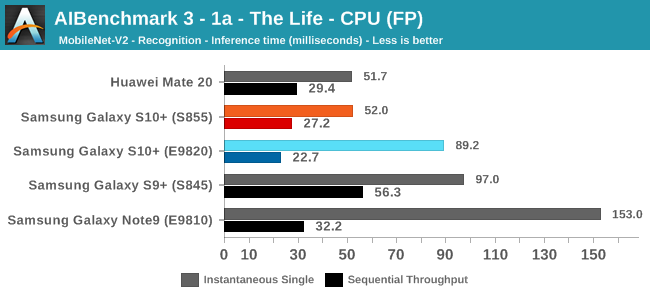
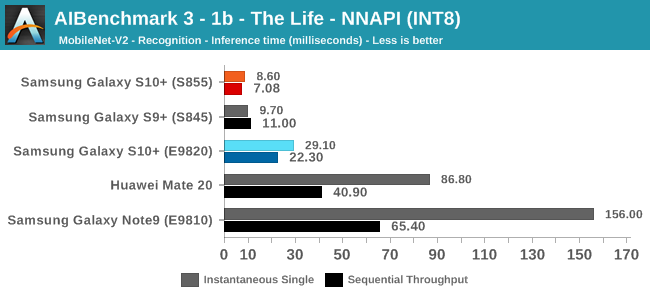
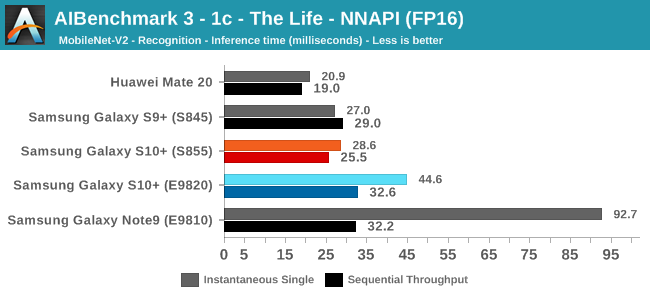

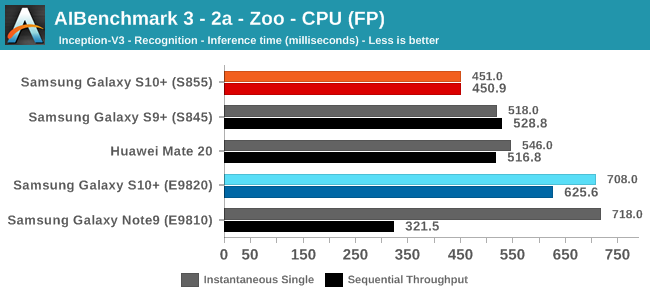
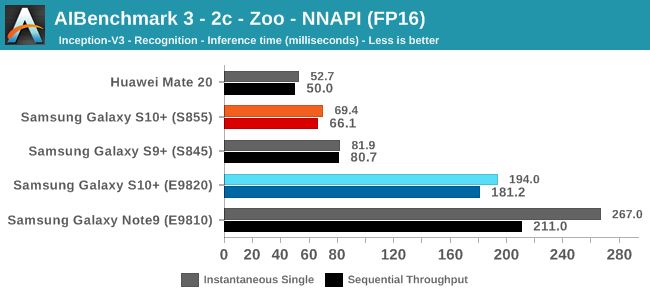
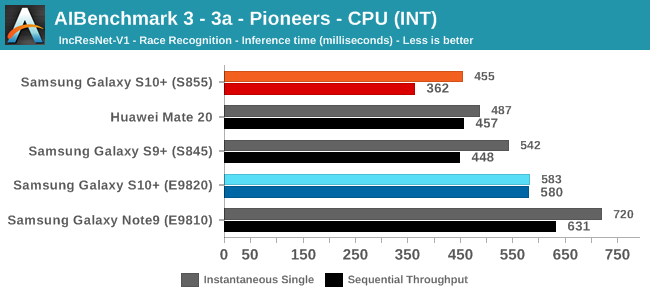
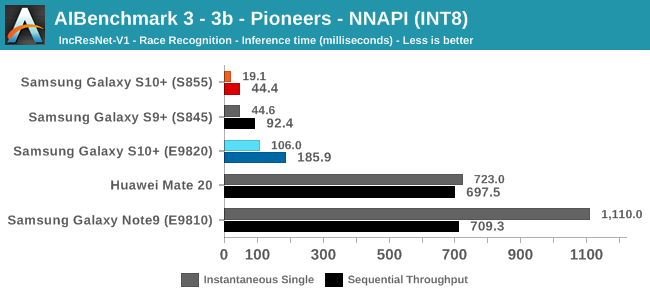
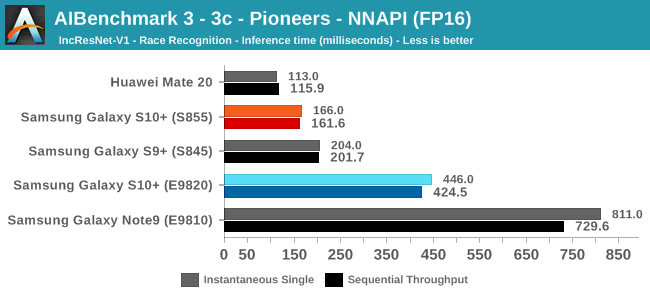

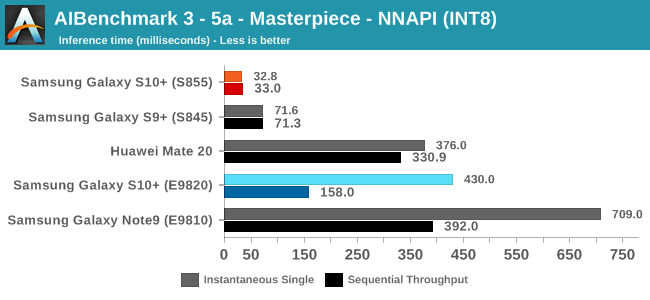
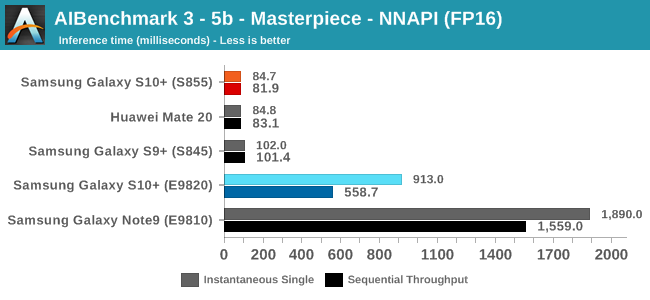
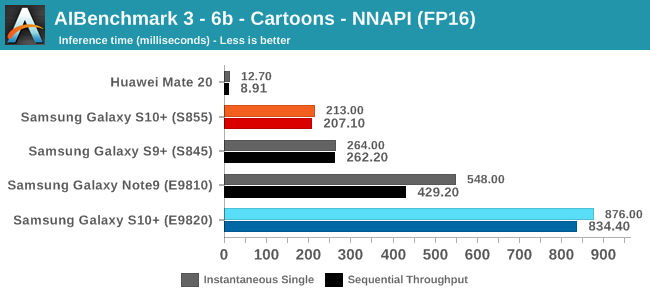






As initially predicted, the results are extremely spread across all the SoCs.
The new tests also include workloads that are solely using TensorFlow libraries on the CPU, so the results not only showcase NNAPI accelerator offloading but can also serve as a CPU benchmark.
In the CPU-only tests, we see the Snapdragon 855 and Exynos 9820 being in the lead, however there’s a notable difference between the two when it comes to their instantaneous vs sequential performance. The Snapdragon 855 is able to post significantly better single inference figures than the Exynos, although the latter catches up in longer duration workloads. Inherently this is a software characteristic difference between the two chips as although Samsung has improved scheduler responsiveness in the new chip, it still lags behind the Qualcomm variant.
In INT8 workloads there is no contest as Qualcomm is far ahead of the competition in NNAPI benchmarks simply due to the fact that they’re the only vendor being able to offload this to an actual accelerator. Samsung’s Exynos 9820 performance here actually has also drastically improved thanks to the new Mali G76’s new INT8 dot-product instructions. It’s odd that the same GPU in the Kirin 980 doesn’t show the same improvements, which could be due to not up-to-date Arm GPU NNAPI drives on the Mate 20.
The FP16 performance crown many times goes to the Kirin 980 NPU, but in some workloads it seems as if they fall back to the GPU, and in those cases Qualcomm’s GPU clearly has the lead.
Finally for FP32 workloads it’s again the Qualcomm GPU which takes an undisputed lead in performance.
Overall, machine inferencing performance today is an absolute mess. In all the chaos though Qualcomm seems to be the only SoC supplier that is able to deliver consistently good performance, and its software stack is clearly the best. Things will evolve over the coming months, and it will be interesting to see what Samsung will be able to achieve in regards to their custom SDK and NNAPI for the Exynos NPU, but much like Huawei’s Kirin NPU it’s all just marketing until we actually see the software deliver on the hardware capabilities, something which may take longer than the actual first year active lifespan of the new hardware.










229 Comments
View All Comments
GekkePrutser - Saturday, March 30, 2019 - link
The orientation of the selfie camera in this case significantly reduces the experience and overall screen space from what would be possible. And smartphones are all about the screen. Making a big hole in it is really annoying.I'd personally find it a lot less flawed if it just left the selfie camera out altogether as I'd gladly do without it, or just kept the bezels.
Tropicocity - Sunday, March 31, 2019 - link
So your solution to what is actually the smallest and least-intrusive version of a 'total full screen display' (screen to body ratio is the highest ever pretty much, save for a few gimmicky ideas) is to remove it entirely?Linus seems to be in love with the front-and-back display idea, where there's a whole extra screen on the rear so you turn the phone around completely to take a selfie. Personally, I think the cutout is way better compared with the 'notch' on other phones. Sure, the s10+ having a double one isn't as nice as the singular one on the regular S10, but you get better depth-sensing and better selfies out of it.
Zoolook - Saturday, March 30, 2019 - link
Isn't that a bit like tying one arm to your back for a while because it's so good when you release it?drajitshnew - Friday, March 29, 2019 - link
Thank you ANDREI. This is really nice, comprehensive, review with very useful conclusions. I really liked it.apexjr - Friday, March 29, 2019 - link
Andrei Frumusanu,You nailed this display part! I actually returned my first S10 yesterday because the calibration wasn't great. I saw way too much greens while looking at a grey display. Nothing I could do fixed it.
On my next S10 the calibration was better. I selected Vivid, max'd out Cool, reduced green by 2 notches. That seemed to get the white closer to white, even though there is still a bit too much red/yellow mixed in. It is acceptable now though.
Would you possibly try adjusting it within the vivid sections to maybe get a better color accuracy?
I don't know what is going on with this display. I bought a S9 for my daughter at the same time and the colors are much better/accurate. The contrast is a bit too punchy though, as dark scenes are rendered too dark. This is what you are talking about and continues to be in the S10 (but to a lesser degree in my two phones).
Thanks!
nicolaim - Friday, March 29, 2019 - link
Typo on the last page: "the SoC represents be"nicolaim - Friday, March 29, 2019 - link
And another: "comfing"Andrei Frumusanu - Friday, March 29, 2019 - link
Thank you.SwordOS - Friday, March 29, 2019 - link
also s10s don't have iris scanner..danwells - Friday, March 29, 2019 - link
There's only one problem with any ultra-high-end Android phone... Apple!If you're going to pay for a phone that's in the Apple price range, the average person would be MUCH better off with an iPhone - you can avoid Android's security problems, ads and tracking entirely. Every performance test posted that included modern iPhones also showed the iPhones are faster and more power efficient.
Yes, there's a small fraction of the market (and a larger fraction of AnandTech's readership) that prefers the greater customizability of Android, and that's fine as long as they're aware of the security risks and don't mind the ads and tracking. 9 out of 10 people who are in the segment of the market that contains the modern iPhone ($750+) are better off with an iPhone, and the other 1/10 know why they don't want one.